 |
National Center for Chronic Disease Prevention and Health Promotion
Arthritis
Home | About Us | Contact Us
|
||||||||
National Center for Chronic Disease Prevention and Health Promotion Arthritis Home | About Us | Contact Us |
||||||||
|
| ||||||||||||||||||||||||||||||||||||||||||||||
|
|
|
|||||||||||||||||||||||||||||||||||||
On this page:
In 2006, the CDC combined data from the National Health Interview Survey years 2003–2005 Sample Adult Core components to estimate average annual arthritis prevalence in the civilian, non-institutionalized U.S. population age 18 years or older. Overall, 21.6% (46.4 million) of adults reported arthritis, with significantly higher age-adjusted prevalence in women than in men (24.4%, [95% confidence interval (CI) 23.9–24.9] vs. 18.1% [17.6–18.6]). Arthritis prevalence increased with age and was higher among women than men in every age group.
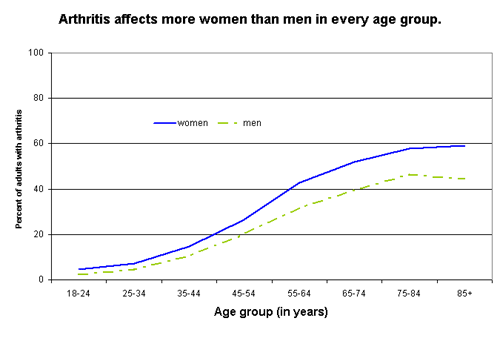
Sex-specific prevalence of doctor-diagnosed arthritis by 10 year age
groups, National Health Interview Survey, 2003-2005
Data Source
Theis KA, Helmick CG, Hootman JM. Arthritis burden and impact are greater among U.S. women than men: intervention opportunities. J Women’s Health 2007;16(4):441–453.
Hootman J, Bolen J, Helmick C, Langmaid G. Prevalence
of doctor-diagnosed arthritis and arthritis-attributable activity
limitation—United States, 2003–2005. MMWR [View the errata for this
article here and
here.]
2006;55(40):1089–1092.
html
![]() pdf
(512K)
pdf
(512K)
With the aging of the U.S. population, the prevalence of doctor-diagnosed arthritis is expected to increase in the coming decades. By the year 2030, an estimated 67 million (25% of the projected total adult population) adults aged 18 years and older will have doctor-diagnosed arthritis, compared with the 46 million adults in 2003–2005. Figure 1 shows that two-thirds of those with arthritis will be women. Also by 2030 an estimated 25 million adults (37% of adults with arthritis or 9.3% of all U.S. adults) will report arthritis-attributable activity limitations. These estimates may be conservative as they do not account for the current trends in obesity, which may contribute to future cases of osteoarthritis.
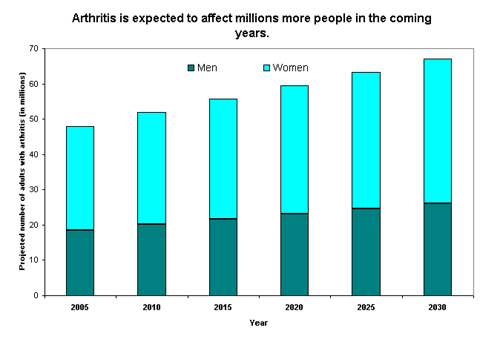
Figure 1. Projected Prevalence of Doctor-Diagnosed Arthritis Among U.S. Adults Ages 18+ Years, 2005-2030 (1)
[A text description of this graph is also available.]
Data Source: 2003–2005 National Health Interview Survey
Hootman JM, Helmick CG. Projections of U.S. prevalence of arthritis and associated activity limitations. Arthritis Rheum 2006;54(1):226–229.
The impact of arthritis on individuals is significant. Almost 41% (19 million) of the 46 million adults with doctor-diagnosed arthritis report limitations in their usual activities due to their arthritis. Figures 2 a and b shows that in addition to activity limitations, 31% (8.3 million) of working age adults with doctor-diagnosed arthritis report being limited in work due to arthritis.
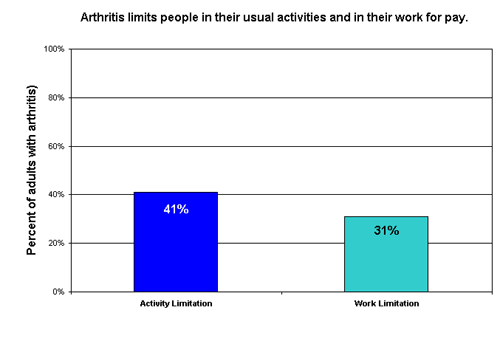
Figure 2a. (1) Arthritis-Attributable Activity Limitation Among Adults with Arthritis (NHIS 2003-2005) and (2) Arthritis-Attributable Work Limitation Among Adults with Arthritis 18-64 Years Old (NHIS 2002)
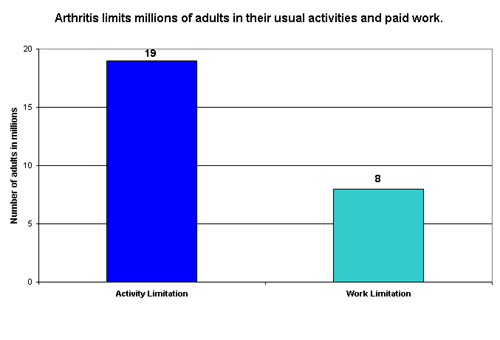
Figure 2b. (1)Arthritis-Attributable Activity Limitation Among Adults with Arthritis, NHIS 2003-2005 and (2) Arthritis-Attributable Work Limitation Among Adults with Arthritis Ages 18-64 Years, NHIS 2002.
[A text description of this graph is also available.]
Data Source: 2002 National Health Interview Survey
Hootman J, Bolen J, Helmick C, Langmaid G. Prevalence of
doctor-diagnosed arthritis and arthritis-attributable activity
limitation—United States, 2003-2005. MMWR [View the errata for
this article
here
and here.]
2006;55(40):1089–1092.
html
![]() pdf (512K)
pdf (512K)
Bolen J, Sniezek J, Theis K, Helmick CG, Hootman JM, Brady TJ et al.
Racial/Ethnic differences in the prevalence and impact of doctor-diagnosed
arthritis—United States, 2002. MMWR 2005;54(5):119–123.
html
![]() pdf
(284K)
pdf
(284K)
NOTE: Arthritis-Attributable Activity Limitation = responding “yes” to “Are you now limited in any way in any of your usual activities due to arthritis or joint symptoms”; Arthritis-Attributable Work Limitation = among working age population (18–64 years), responding “yes” to being limited in the type, amount, or whether they work due to arthritis.
Functional limitations in common daily activities are common among adults with arthritis; 40% report it is “very difficult” or they “cannot do” at least 1 of 9 important daily functional activities. For example, almost 8 million adults who report an activity limitation due to their arthritis also report severe limitation in their ability to stoop, bend or kneel, and 6 million cannot walk ¼ mile. Figure 3 shows the prevalence of specific functional limitations. Impairment in the ability to perform essential daily living activities may interfere with the ability of people with arthritis to work, function in their community, or care for their family.
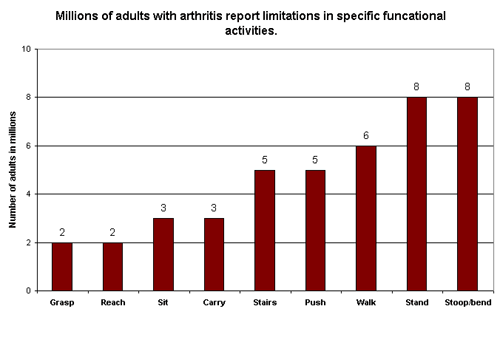
Figure 3. Functional limitation is defined as "very difficult" or "cannot do" for the following activities: grasp small objects; reach above ones head; sit more than 2 hours; lift or carry 10 pounds; climb a flight of stairs; push a heavy object; walk a 1/4 mile; stand more than 2 hours; stoop, bend, or kneel, NHIS 2002.
[A text description of this graph is also available.]
Data Source: 2002 National Health Interview Survey
Hootman JM, Jeffrey Sacks JJ, Helmick CG. Prevalence of arthritis-attributable activity limitations among adults with doctor-diagnosed arthritis, United States, 2002. Arthritis Rheum 2004;50(9, suppl):5641.
Obesity is a known risk factor for the development and progression of knee osteoarthritis and possibly osteoarthritis of other joints. For example, obese adults are up to 4 times more likely to develop knee osteoarthritis than normal weight adults1. Excess body weight is also associated with about 35% of adults with doctor-diagnosed arthritis are obese compared to only 21% of those without arthritis. Reducing body weight may result in significant improvements in the health-related quality of life of people with arthritis.
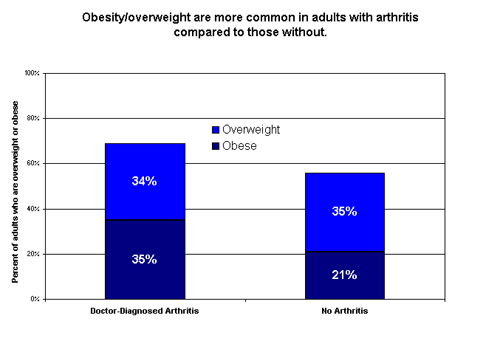
Figure 4. Distribution of Body Mass Index* Among Adults With and Without Arthritis, NHIS 2002
[A text description of this graph is also available.]
Data source: 2002 National Health Interview Survey
Felson DT, Zhang Y. An update on the epidemiology of knee and hip osteoarthritis with a view to prevention. Arthritis Rheum 1998;41(8):1343–1355.
*NOTE: Body Mass Index (BMI) calculated using the formula weight in kilograms/height in meters2. Underweight/normal=BMI < 25; Overweight = BMI 25-29.99; Obese = BMI ≥ 30.
Although physical activity and exercise have been shown to benefit people with arthritis by improving pain, function, and mental health, many people with arthritis report no leisure time physical activity. Almost 44% of adults with doctor-diagnosed arthritis report no leisure time physical activity, a considerably higher proportion compared with adults without arthritis (36%). Low levels of physical activity place individuals with arthritis at further risk of inactivity-associated conditions such as cardiovascular disease, diabetes, obesity, and functional limitations.
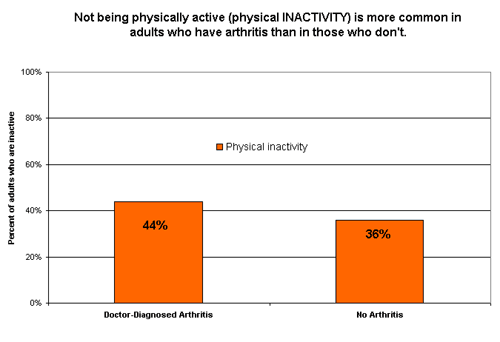
Figure 5. Prevalence of Physical Inactivity Among Adults with and without Arthritis, NHIS 2002
[A text description of this graph is also available.]
Data Source
Shih M, Hootman JM, Kruger J, Helmick CG. Physical activity in men and women with arthritis, National Health Interview Survey, 2002. Am J Prev Med 2006;30(5):385-93.
*NOTE: Inactive = no reported leisure-time physical activity.